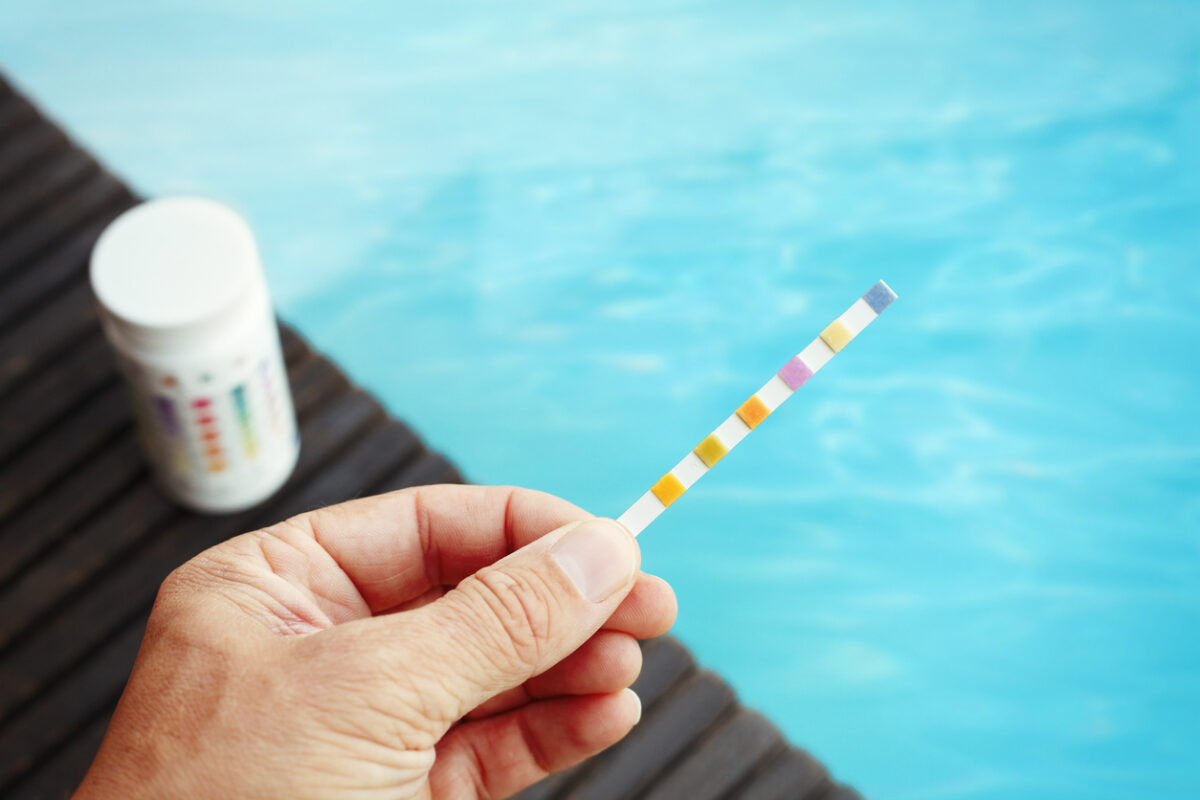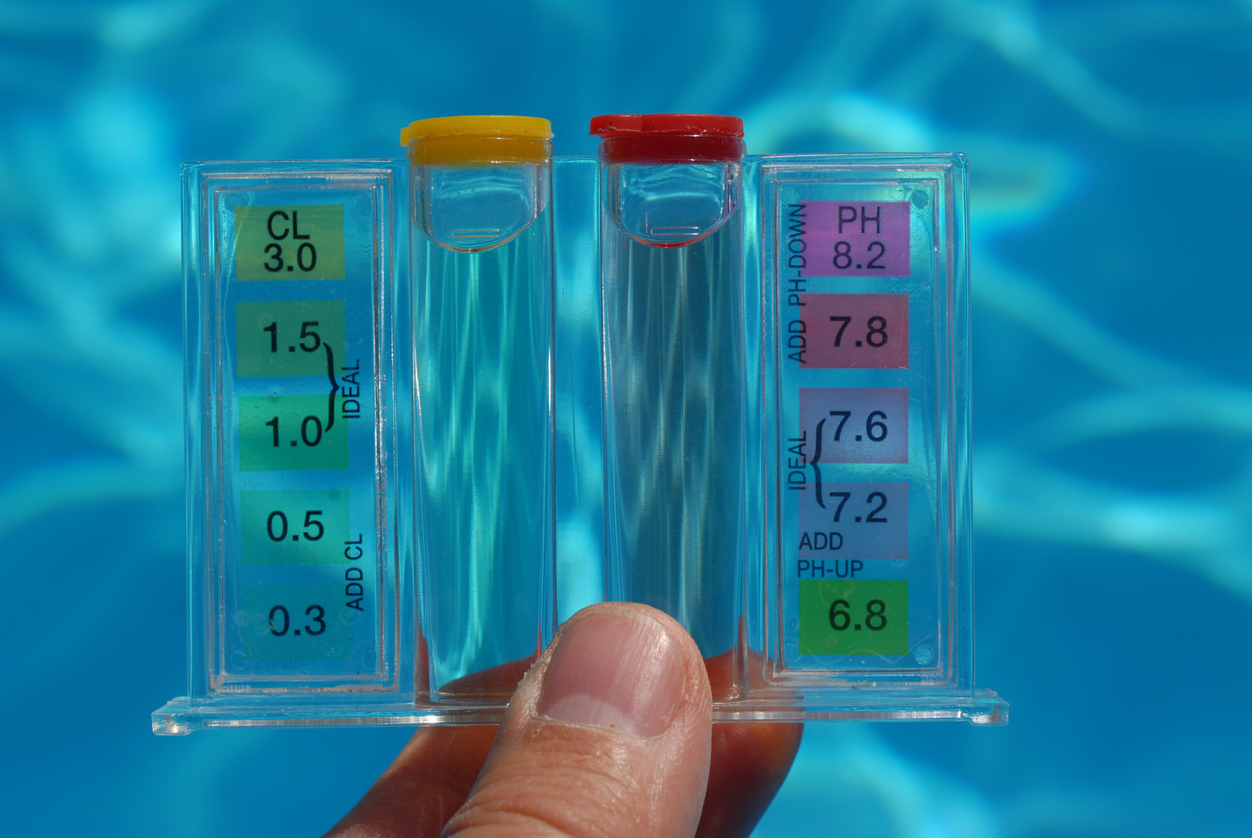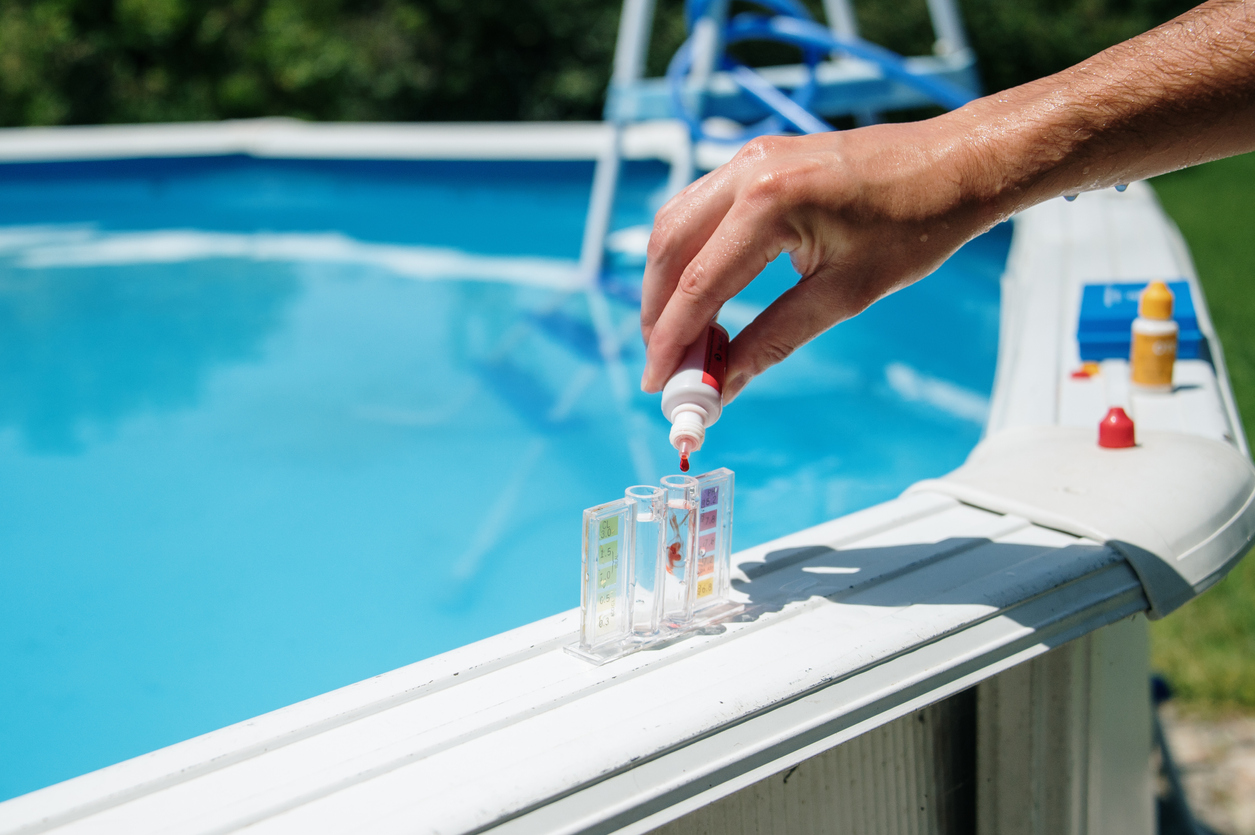

We may earn revenue from the products available on this page and participate in affiliate programs. Learn More ›
Keeping the water clean, clear, and ready for swimmers is one of the most important aspects of maintaining a swimming pool. Testing swimming pool water allows you to monitor chlorine and pH levels (and often total alkalinity and hardness levels) and lets you know whether any adjustments should be made.
While testing the water in your home swimming pool isn’t too difficult, you do need to learn about the various tools you’ll need and how to use them. Below, you’ll learn how to test pool water to keep your home pool safe and ready to use.
RELATED: Inground Pool Cost Guide: What to Know, and How Much to Expect You’ll Pay
When to Test Your Pool and What to Look For

Before learning how to test your pool water at home, it is important to understand what you’re looking for when you test. Pool test kits measure free chlorine (chlorine in water that has yet to bond with contaminant molecules) and pH levels, and some also check for calcium hardness or total alkalinity. Keeping these levels balanced will help prevent cloudy pool water. It will also help make sure that the water doesn’t irritate the skin or eyes of swimmers and keep your pool from turning green.
In most cases, you should aim to test your chlorine and pH levels at least two or three times each week. You should also test for pH and chlorine after rainstorms, if several swimmers were recently in the pool, after adding water to bring up the water level, or if you see any signs that something is wrong—such as cloudy water or color changes. Unless the pH has changed, total alkalinity should be checked weekly If the pH has changed, check it each time you test for pH. Calcium hardness, meanwhile, just requires a monthly check.
Below are the ideal ranges for free chlorine, pH, total alkalinity, and calcium hardness. Keep in mind that the ideal free chlorine level should be higher than the combined chlorine level to ensure that effective sanitization occurs.
- Free chlorine: 1.0 to 4.0 parts per million
- pH: 7.2 to 7.6
- Total alkalinity: 80 to 120 parts per million
- Calcium hardness: 175 to 275 parts per million
Pool Test Kits vs. Pool Test Strips
Either pool test kits or pool test strips can be used for testing pool water. There are pros and cons for each option to consider.
Pool test strips are the easiest way to test pool water. After collecting a sample of pool water and dipping the test strip in the water, the strip will change colors that you can compare to the key on the test strip container. There are some downsides to using pool test strips, however. Each strip can only be used once, so you’ll need to purchase replacements more frequently. Additionally, test strips results are typically not as accurate as those you’ll get with a pool test kit.
Although pool test kits, also called liquid test kits or reagent test kits, take a bit more time to use, they are more accurate than test strips. Use of these kits involves collecting a sample of water and adding drops of different reagents to assess the chlorine and pH levels. There are two different types of reagent test kits: orthotolidine (OTO) and N,N-diethyl-p-phenylenediamine (DPD). DPD test kits can check both free and total chlorine levels, while OTO test kits only read total chlorine levels.
RELATED: 10 Reasons to Reconsider the Above-Ground Pool
How to Test a Pool With Test Strips

As explained above, using test strips is the easiest way to test pool water, although this method is generally less accurate than . Read on to learn how to check pool water for balanced chemical levels using test strips.
SUPPLIES
STEP 1: Wash and dry your hands before taking a test strip out of the packaging.
Before testing the water using a test strip, wash your hands with hand soap to remove any potential contaminants and fully dry them. Then, remove one test strip out of the bottle. Tightly seal the bottle to protect the remaining strips from contamination.
STEP 2: Submerge the test strip in the pool for 15 seconds.
Move away from any jets or skimmers—the middle of the pool is ideal—and submerge the test strip at least 18 inches below the surface of the water (approximately elbow-depth). Hold the strip underwater for 15 seconds, or the amount of time specified for your pool test strips.
STEP 3: Remove the test strip from the water and compare the colors to the provided chart.
Pull the test strip out of the water. Compare the colors on the strip for each testing parameter against the chart on the bottle or packaging. Record the results so you can refer back to them and monitor changes in the levels between tests.
RELATED: 8 of the Best Inflatable Pools Today, Tested
How to Test a Pool With a Liquid Test Kit

If you’re looking for the best way to test pool water, using a liquid test kit is advised. These testing kits offer the most accurate readings. And, while using them may be a bit more involved than using test strips, they are still relatively user-friendly. The general instructions below are based on most standard pool test kits, but be sure to thoroughly read and follow your specific product’s instructions.
SUPPLIES
STEP 1: Remove the caps from each tube and rinse out the interiors.
Remove the caps covering each tube in the pool test kit. Then, rinse out the tubes to remove any potential contaminants.
STEP 2: Collect water samples away from pool skimmers or jets.
Move to an area of the pool that is away from the skimmers or jets. Turn the tubes upside down and dip them approximately 18 inches below the surface of the water before pulling them back out of the water.
STEP 3: Add reagents to the samples according to the manufacturer’s directions.
Follow the manufacturer’s directions to add the appropriate reagents to each tube. For most test kits, the tube on the left side measures chlorine and the tube on the right side tests pH levels.
STEP 4: Close and gently shake the tubes, and record the readings.
Place the caps back on each tube to seal them. Gently shake or swirl the reagents with the water to fully combine the different liquids. Compare the color of the water with the colors on the sides of each tube, and record the readings. Placing a blank sheet of white paper behind the tubes can make it easier to compare the colors.
Final Thoughts

Home pool water testing is an essential part of both in-ground and above-ground pool maintenance. Pool test kits and test strips allow you to monitor essential pool chemistry levels so you can know whether the chlorine or pH needs to be adjusted. Following the steps outlined above should help you understand how to test swimming pool water using your preferred method—either a pool test kit or test strips.
RELATED: The Best Above-Ground Pools
